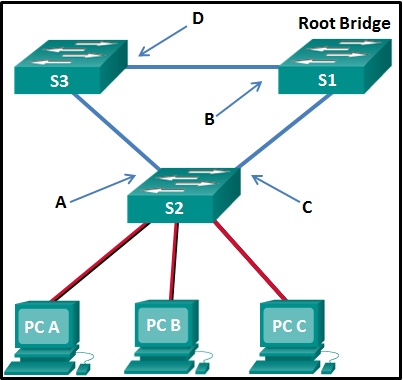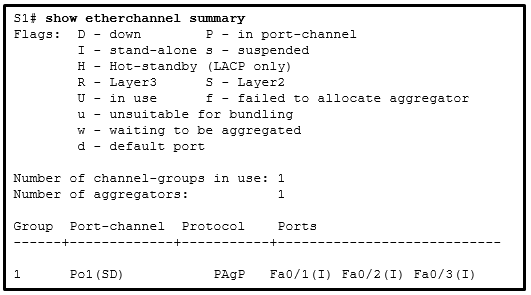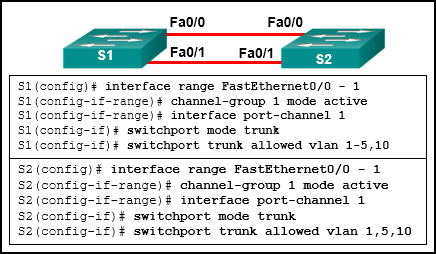1. What is the outcome of a Layer 2 broadcast storm?
7. In which two port states does a switch learn MAC addresses and process BPDUs in a PVST network? (Choose two.)
10. When the show spanning-tree vlan 33 command is issued on a switch, three ports are shown in the forwarding state. In which two port roles could these interfaces function while in the forwarding state? (Choose two.)

Which set of configuration commands issued on SW1 will successfully complete the EtherChannel link between SW1 and SW2?

SW1: on
SW2: on
SW1: desirable
SW2: desirable
SW1: auto
SW2: auto
trunking enabled on both switches
SW1: auto
SW2: auto
PortFast enabled on both switches
SW1: passive
SW2: active
50. Refer to the exhibit. An EtherChannel was configured between switches S1 and S2, but the interfaces do not form an EtherChannel. What is the problem?

54. What additional information is contained in the 12-bit extended system ID of a BPDU?
- Routers will take over the forwarding of frames as switches become congested.
- New traffic is discarded by the switch because it is unable to be processed.
- CSMA/CD will cause each host to continue transmitting frames.
- ARP broadcast requests are returned to the transmitting host.
- static default routes
- implementing VLANs to contain broadcasts
- redundant links between Layer 2 switches
- link-state dynamic routing that provides redundant routes
- removing single points of failure with multiple Layer 2 switches
- Spanning Tree Protocol will transition the failed physical interface into forwarding mode.
- Spanning Tree Protocol will recalculate the remaining trunk links.
- The EtherChannel will transition to a down state.
- The EtherChannel will remain functional.
- bridge ID
- edge port
- extended system ID
- PortFast
- PVST+
- extended system ID
- cost
- IP address
- bridge priority
- MAC address
- port ID
7. In which two port states does a switch learn MAC addresses and process BPDUs in a PVST network? (Choose two.)
- disabled
- forwarding
- listening
- blocking
- learning
- lowest MAC address
- lowest IP address
- highest IP address
- highest MAC address
10. When the show spanning-tree vlan 33 command is issued on a switch, three ports are shown in the forwarding state. In which two port roles could these interfaces function while in the forwarding state? (Choose two.)
- alternate
- designated
- disabled
- blocked
- root
- It decreases the size of the failure domain to contain the impact of failures.
- It protects the edge of the enterprise network from malicious activity.
- It combines multiple switch trunk links to act as one logical link for increased bandwidth.
- It disables redundant paths to eliminate Layer 2 loops.
- It is enabled by default on Cisco switches.
- It is used to discover information about an adjacent Cisco device.
- It has a TTL mechanism that works at Layer 2.
- It prevents propagation of Layer 2 broadcast frames.
- PVST+
- 802.1D
- MST
- Rapid PVST
- creates smaller collision domains
- prevents routing loops on a router
- prevents Layer 2 loops
- allows Cisco devices to exchange routing table updates
- creates smaller broadcast domains
- the path cost
- the highest MAC address of all the ports in the switch
- the lowest MAC address of all the ports in the switch
- the VTP revision number
- S1
- S2
- S3
- S4
- The MAC address table becomes unstable.
- The switch acts like a hub.
- Port security becomes unstable.
- Broadcast frames are transmitted indefinitely.
- Port security shuts down all of the ports that have attached devices.
- 1
- 28672
- 32768
- 34816
- 61440
- Traffic cannot be sent to two different switches through the same EtherChannel link.
- Traffic cannot be sent to two different switches, but only to two different devices like an EtherChannel-enabled server and a switch.
- Traffic can only be sent to two different switches if EtherChannel is implemented on Gigabit Ethernet interfaces.
- Traffic can only be sent to two different switches if EtherChannel is implemented on Layer 3 switches.
- It requires full duplex.
- It increases the number of ports that are participating in spanning tree.
- It requires more physical links than LACP does.
- It mandates that an even number of ports (2, 4, 6, etc.) be used for aggregation.
- It is Cisco proprietary.
- All the interfaces need to work at the same speed.
- All interfaces need to be assigned to different VLANs.
- Different allowed ranges of VLANs must exist on each end.
- All the interfaces need to be working in the same duplex mode.
- The interfaces that are involved need to be contiguous on the switch.
CCNA-2-v7-Modules 5 – 6 Redundant Networks Exam 22
- The EtherChannel bundle is down.
- Two Gigabit Ethernet ports are used to form the EtherChannel.
- A Cisco proprietary protocol was used to negotiate the EtherChannel link.
- The EtherChannel bundle is operating at both Layer 2 and Layer 3.
- port ID
- PAgP mode
- MAC address
- speed
- VLAN information
CCNA-2-v7-Modules 5 – 6 Redundant Networks Exam 24
- The EtherChannel is established after SW2 initiates the link request.
- The EtherChannel is established after SW1 initiates the link request.
- The EtherChannel is established without negotiation.
- The EtherChannel fails to establish.
CCNA-2-v7-Modules 5 – 6 Redundant Networks Exam 25
- Configure SW2 EtherChannel mode to desirable.
- Configure SW2 EtherChannel mode to on.
- Configure SW1 EtherChannel mode to on.
- Configure SW2 EtherChannel mode to auto.
- The remaining two interfaces continue to load balance traffic.
- The remaining two interfaces become separate links between the two switches.
- One interface becomes an active link for data traffic and the other becomes a backup link.
- The EtherChannel fails.
- SW2(config-if-range)# channel-group 1 mode passive
- SW2(config-if-range)# channel-group 1 mode desirable
- SW2(config-if-range)# channel-group 1 mode on
- SW2(config-if-range)# channel-group 1 mode active
- PAgP
- LACP
- Multilink PPP
- DTP
- The allowed range of VLANs must be the same on both switches.
- The participating interfaces must be assigned the same VLAN number on both switches.
- The participating interfaces must be physically contiguous on a switch.
- The participating interfaces must be on the same module on a switch.
- It allows directly connected switches to negotiate an EtherChannel link.
- It eliminates the need for configuring trunk interfaces when deploying VLANs on multiple switches.
- It decreases the amount of configuration that is needed on a switch.
- It provides a simulated environment for testing link aggregation.
- It allows the use of multivendor devices.
- LACP allows Fast Ethernet and Gigabit Ethernet interfaces to be mixed within a single EtherChannel.
- root port
- designated port
- alternate port
- disabled
- Spanning Tree Protocol views the physical links in an EtherChannel as one logical connection.
- Load balancing occurs between links configured as different EtherChannels.
- Configuring the EtherChannel interface provides consistency in the configuration of the physical links.
- Spanning Tree Protocol ensures redundancy by transitioning failed interfaces in an EtherChannel to a forwarding state.
- EtherChannel uses upgraded physical links to provide increased bandwidth.

Modules 5 – 6: Redundant Networks Exam 33
- alternate, designated, root, root
- designated, alternate, root, root
- alternate, root, designated, root
- designated, root, alternate, root
CCNA-2-v7-Modules 5 – 6 Redundant Networks Exam 02
- trunking
- HSRP
- PortFast
- EtherChannel
CCNA-2-v7-Modules 5 – 6 Redundant Networks Exam 06
- auto
- on
- off
- desirable
Which set of configuration commands issued on SW1 will successfully complete the EtherChannel link between SW1 and SW2?
CCNA-2-v7-Modules 5 – 6 Redundant Networks Exam 36
- interface GigabitEthernet0/1
no shutdown - interface Port-channel 1
no shutdown - interface GigabitEthernet0/2
channel-group 2 mode desirable - interface GigabitEthernet0/1
channel-group 1 mode desirable
- 65535
- 4096
- 32768
- 61440
- learning
- forwarding
- disabled
- listening
- blocking
- designated port
- disabled port
- root port
- non-designated port
- root port
- designated port
- alternate port
- disabled
- extended system ID
- port ID
- bridge priority
- bridge ID
- root bridge
- root port
- designated port
- alternate port
- bridge priority
- MAC Address
- extended system ID
- bridge ID
- EtherChannel operates only at Layer 2.
- PAgP cannot be used in conjunction with EtherChannel.
- A trunked port can be part of an EtherChannel bundle.
- EtherChannel can support up to a maximum of ten separate links.

CCNA2 v7 SRWE – Modules 5 – 6 Redundant Networks Exam Answers
- The EtherChannel is suspended.
- The EtherChannel is not functional.
- The port aggregation protocol PAgP is misconfigured.
- FastEthernet ports Fa0/1, Fa0/2, and Fa0/3 do not join the EtherChannel.
- It can combine up to a maximum of 4 physical links.
- It can bundle mixed types of 100 Mb/s and 1Gb/s Ethernet links.
- It consists of multiple parallel links between a switch and a router.
- It is made by combining multiple physical links that are seen as one link between two switches.
- on
- desirable
- active
- auto
- passive
SW1: on
SW2: on
SW1: desirable
SW2: desirable
SW1: auto
SW2: auto
trunking enabled on both switches
SW1: auto
SW2: auto
PortFast enabled on both switches
SW1: passive
SW2: active
50. Refer to the exhibit. An EtherChannel was configured between switches S1 and S2, but the interfaces do not form an EtherChannel. What is the problem?

CCNA2 v7 SRWE – Modules 5 – 6 Redundant Networks Exam Answers 50
- The interface port-channel number has to be different on each switch.
- The switch ports were not configured with speed and duplex mode.
- The switch ports have to be configured as access ports with each port having a VLAN assigned.
- The EtherChannel was not configured with the same allowed range of VLANs on each interface.
- active
- auto
- on
- desirable
- combination of source port and IP to destination port and IP
- source IP to destination IP
- source port to destination port
- combination of source MAC and IP to destination MAC and IP
- source MAC to destination MAC
- STP
- Rapid PVST+
- PVST+
- MST
54. What additional information is contained in the 12-bit extended system ID of a BPDU?
- MAC address
- VLAN ID
- IP address
- port ID
- Each switch with a lower root ID than its neighbor will not send BPDUs.
- All the switches send out BPDUs advertising themselves as the root bridge.
- Each switch determines the best path to forward traffic.
- Each switch determines what port to block to prevent a loop from occurring.
- designated port
- root port
- alternate
- disabled port











0 commentaires:
Enregistrer un commentaire